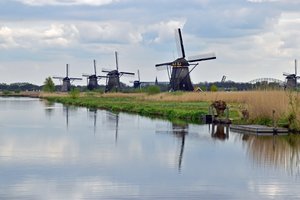Advertisement
Published: September 23rd 2023

 Windmills of the Nederwaard
Windmills of the Nederwaard
Kinderkijk Windmills of the Nederwaard. Kinderdijk has nineteen original windmills that the Water Board uses to drain the polder. Overwaard's wooden mills and Nederwaard's brick mills use wind power to move water from the polders to the basins. The vanes (sails) span up to thirty metres.
Mill Network at Kinderdijk-Elshout UNESCO World Heritage Site.
"The outstanding contribution made by the people of the Netherlands to the technology of handling water is admirably demonstrated by the installations in the Kinderdijk-Elshout area. Construction of hydraulic works for the drainage of land for agriculture and settlement began in the Middle Ages and have continued uninterruptedly to the present day. The site illustrates all the typical features associated with this technology – dykes, reservoirs, pumping stations, administrative buildings and a series of beautifully preserved windmills".
DSC_0481p1We traveled by motorcoach from Dordrecht to Kinderdijk,
the land of windmills. This was the second visit Susan and I have made to this town of windmills. The first was in 2019, and you can read my blog entry from that visit and compare. Then we arrived by river, as Viking maintains a dock here. Gate 1 Travel does not, necessitating the motorcoach transfer. Arrival by road also meant we were given a view of the town of Kinderdijk itself.
The windmills of Kinderdijk form the Mill Network at Kinderdijk-Elshout UNESCO World Heritage site. There are 19 windmills to see here, the earliest dating to the 17th century. They are positioned along two rows. The Overwaard's wooden mills and Nederwaard's brick mills of 1798 use wind power to move water from the polders to the basins. The Overwaard mills form a line to the left, while the Nederwaard mills form a line to the right. The surrounding land is below sea level. Water is pumped into a channel emptying into the River Lek. On this visit, we had a sightseeing boat ride along the channel to view the windmills from water level. The windmills are no longer used for their

 Greylag Goose
Greylag Goose
A Greylag Goose (Anser anser) family at Kinderdijk.
DSC_0485original purpose of pumping water. That has been taken over by a modern pumping station. Except for the windmills set up as museum displays, the mills are inhabited. Some are inhabited by families who have been living here since the 18th century. All of them must maintain the mill with which they are associated.
This tour group did not visit the Wisboom Pumping Station and its informative interpretive and mechanical displays. Nor was a great deal of mention made of it. (We did the boat tour instead, which was not included last time.)
Near the visitor center, street vendors were selling cheese and Dutch pancakes. We bought some cheese to take home and some warm stroopwaffles with filling to eat as a snack. Kinderdijk was also a great place for bird watching, with the Canada Goose, Eurasian Coot, Graylag Goose, and Great Crested Grebe seen.
The drive back to Dordrecht along De Lek presented a landscape dotted with windmills of many types. They were a reminder that Dutch windmills, while all quite similar in appearance, may serve different functions. They might be pumping or drainage mills, gristmills, or peeling and husking mills.
Advertisement
Tot: 0.087s; Tpl: 0.014s; cc: 18; qc: 30; dbt: 0.0433s; 1; m:domysql w:travelblog (10.17.0.13); sld: 1;
; mem: 1.1mb

 Windmills of the Nederwaard
Windmills of the Nederwaard
 Greylag Goose
Greylag Goose







































D MJ Binkley
Dave and Merry Jo Binkley
The beauty of the Netherlands
The windmills are lovely.